Minds On
Let’s get started!
The art of Jacob Lawrence
Explore the following paintings.
- What kinds of stories are being told?
- What do you notice about the style of the paintings?
Record your ideas on paper, digitally, or as an audio recording.
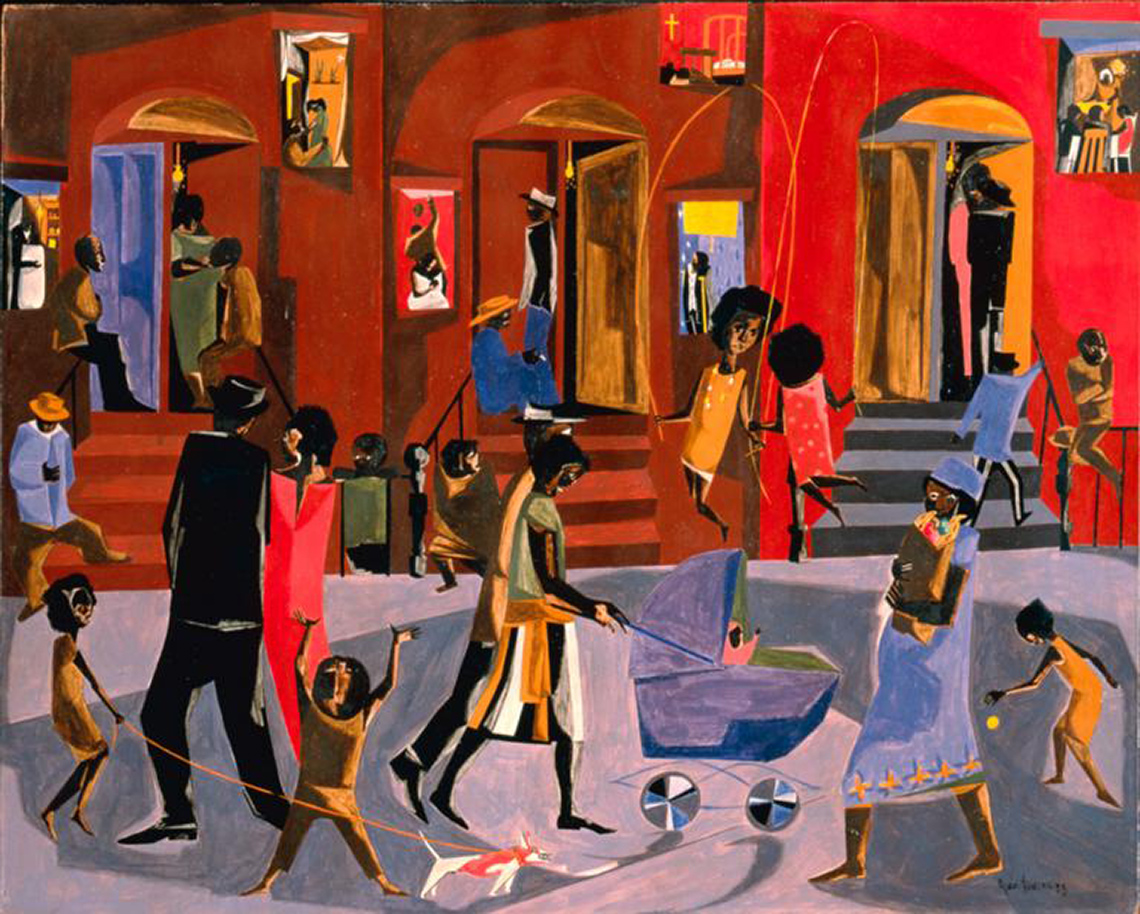
Brownstone by Jacob Lawrence, 1958
This painting was created using bold colours including reds, blues, yellows, browns, black and white. There are many people in a street in front of an apartment building with their doors open and people sitting and standing on their porches. There are children walking a dog, some playing, and some sitting. There are adults out for a walk and others sitting together and others watching the walkers.
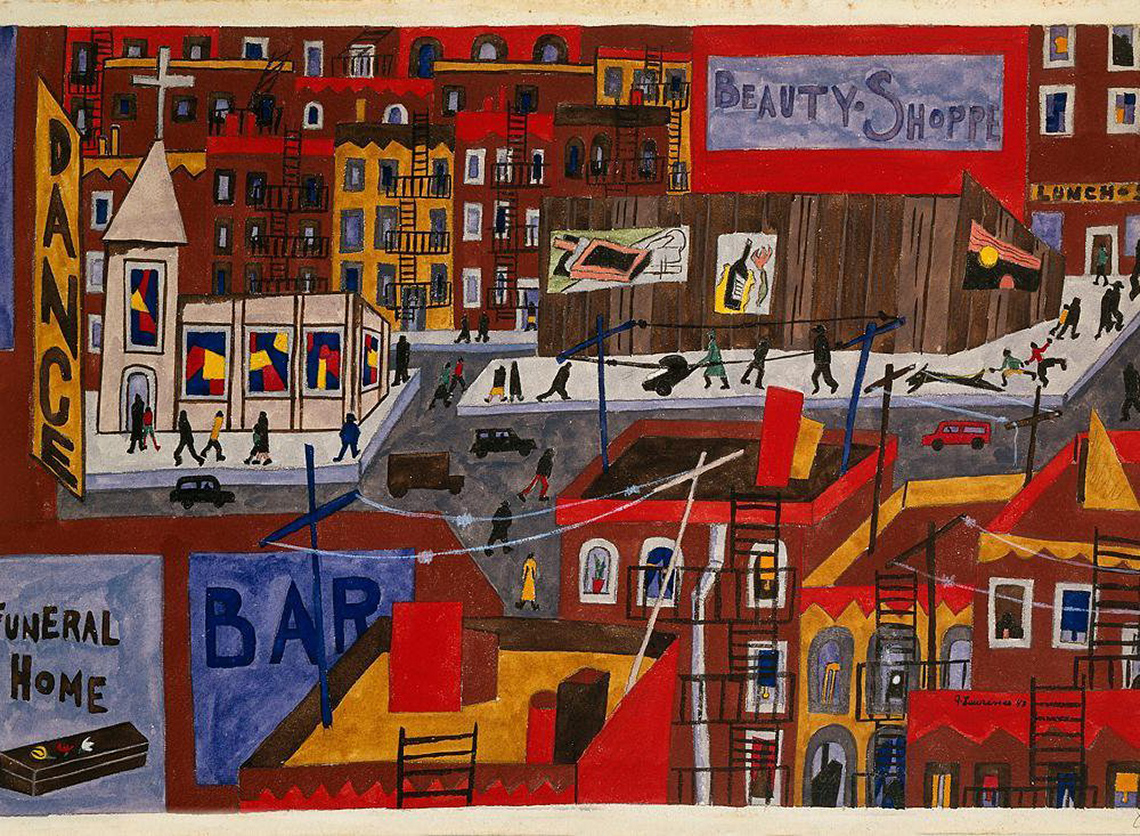
This is Harlem by Jacob Lawrence, 1943
This painting was created using bold colours including reds, blues, yellows, browns, black and white. There are many streets being shown in a neighbourhood. There is a church, apartment buildings, a large wooden fence with posters on it, and people out walking, playing, and spending time together.
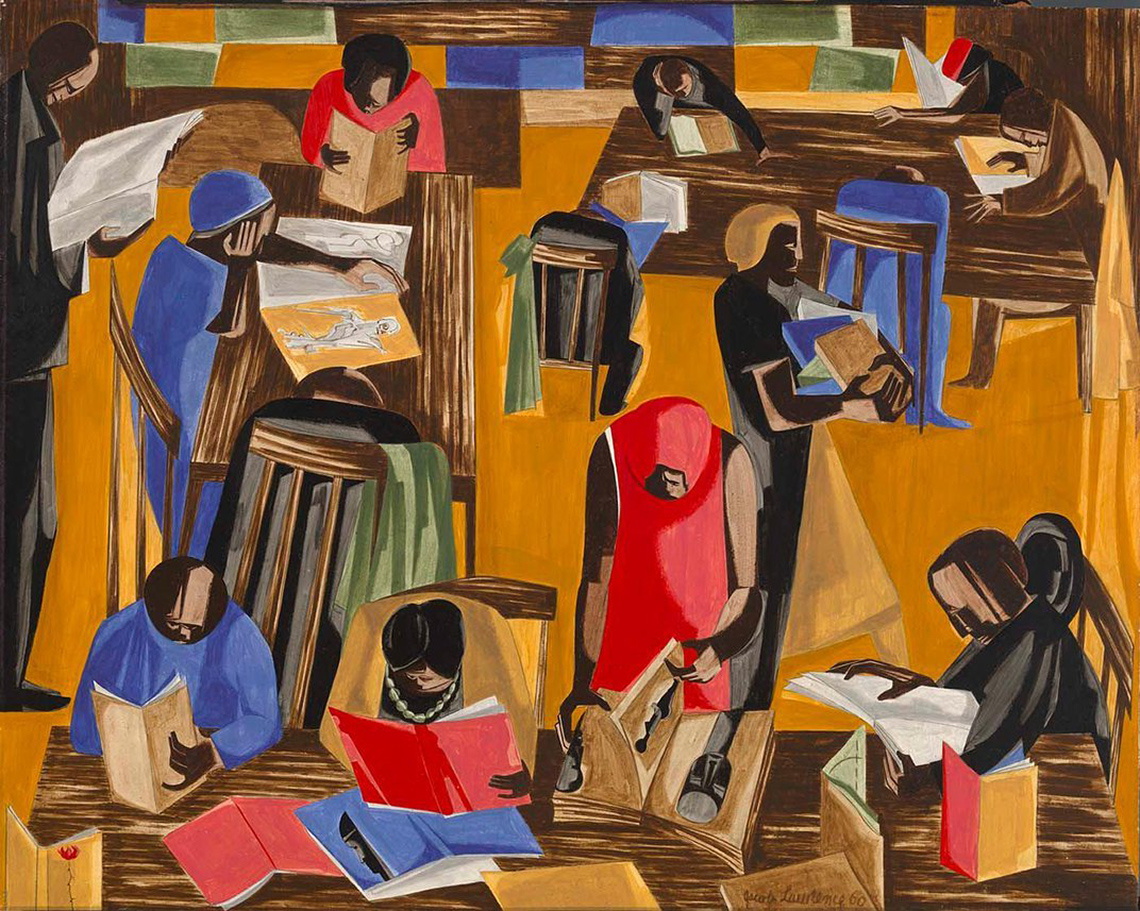
The Library by Jacob Lawrence, 1960
This painting shows a group of people in a library. The bold colours used are yellows, blues, and reds with browns and black included. There are about twelve people in this painting and most of them are sitting, reading. There are books, newspapers, magazines, being read and other books sitting on the tables around the people.
Action
Get ready, get set…
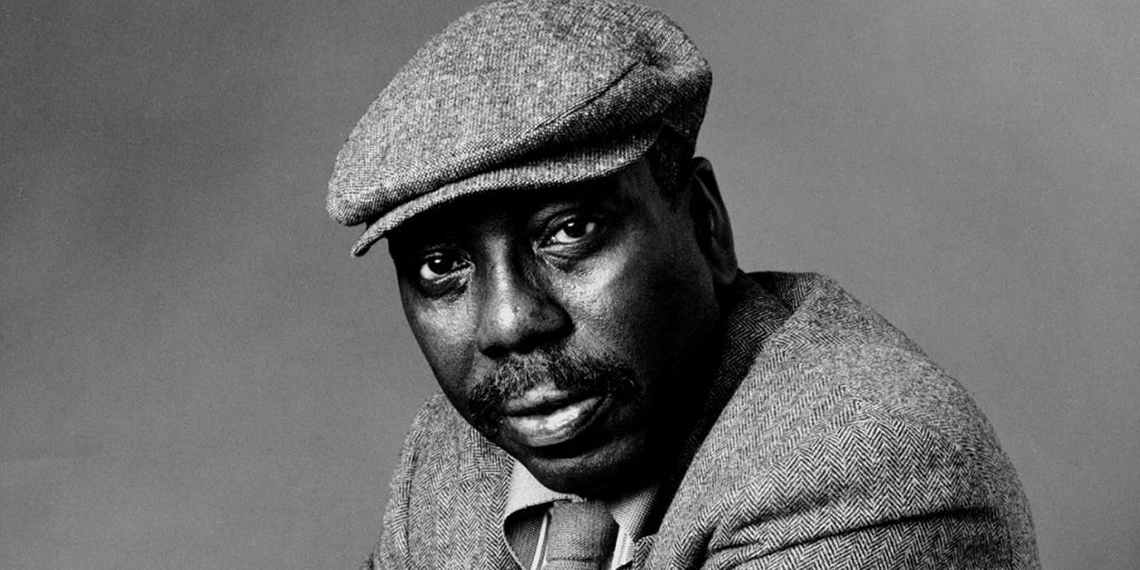
Who is Jacob Lawrence?
Jacob Lawrence was a painter, storyteller, and teacher. He wanted to tell stories about the lives of African Americans from his own community.
How does he represent his community?
Lawrence represented his community by painting pictures of the people and places in his life. He lived in Harlem, New York City for many years. It was important to him to share moments from people’s everyday lives. His paintings include his neighborhood.
In his work, Jacob Lawrence created titles that described what each piece was about.
What is a brownstone?

A brownstone is a style of housing built from a material called sandstone. This type of stone has a reddish-brown colour. During the 1840s-1890s it was easy to find and cut sandstone, and many brownstone row homes were created.
Go!
Let’s explore the painting titled Brownstone.

Brownstone by Jacob Lawrence, 1958
This painting was created using bold colours including reds, blues, yellows, browns, black and white. There are many people in a street in front of an apartment building with their doors open and people sitting and standing on their porches. There are children walking a dog, some playing, and some sitting. There are adults out for a walk and others sitting together and others watching the walkers.
What is happening? What are the people doing in this painting?
Press 'Let’s Check' to reveal a possible answer.
There are a lot of people doing different things in front and inside the brownstone homes in Harlem, New York. People are walking together on the street, a couple is pushing a baby carriage, and a person is carrying a bag of groceries. There are people speaking or waving from their windows some are standing and sitting at the doors of their homes. There are children playing with balls and jump rope.
How does Jacob Lawrence use colour and shape in this painting?
Press 'Let’s Check' to reveal a possible answer.
There are big solid blocks of colour that Jacob Lawrence used to create the brownstone homes. He also used blocks of bright warm and cool colours to create show people’s clothing. He also uses colours that repeat in different parts of the painting (i.e., blue for a door, blue for the baby carriage, and clothing for different people in the painting) There are rectangles used for the doors of the brownstone, and the stairs.
Let’s explore another painting titled This is Harlem. This painting gives us a different perspective from Brownstone. It shares a part of a cityscape.
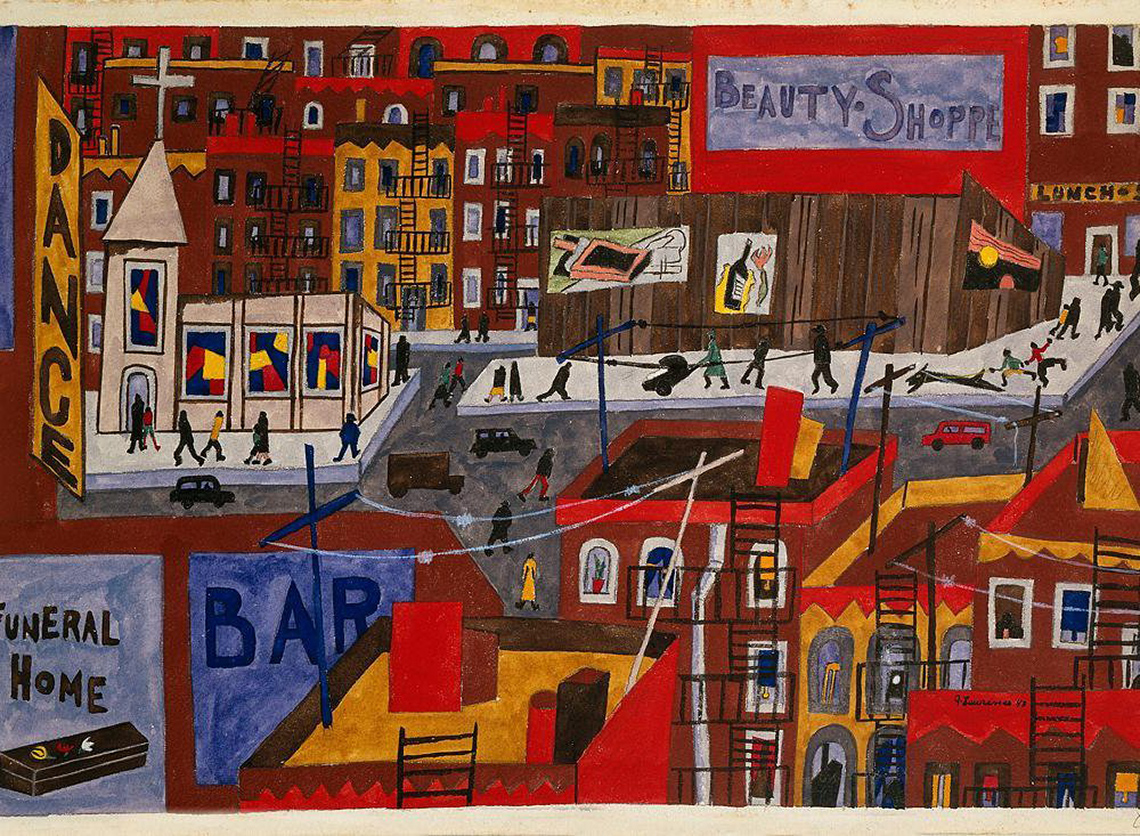
This is Harlem by Jacob Lawrence, 1943
This painting was created using bold colours including reds, blues, yellows, browns, black and white. There are many streets being shown in a neighbourhood. There is a church, apartment buildings, a large wooden fence with posters on it, and people out walking, playing, and spending time together.
What do you notice about this painting? What did Jacob Lawrence capture for the audience?
Press 'Let’s Check' to reveal a possible answer.
This painting includes a lot of different buildings, and shows people walking through the city. There are cars and a truck on the road, and outside ladders attached the buildings.
How is it similar or different from Brownstone?
Press 'Let’s Check' to reveal a possible answer.
This painting shares a bigger part of the Harlem neighborhood. Brownstone shares one part of the Harlem neighborhood.
How does Jacob Lawrence use colour and shape in this painting?
Press 'Let’s Check' to reveal a possible answer.
He used the primary colours red, blue and yellow as well as white, black and brown to create this work. He used rectangles and triangles to create the buildings.
How does Jacob Lawrence create depth in this painting? Does Jacob Lawrence create a foreground, middle ground and background in this painting?
Press the following tabs to access the definitions for depth, foreground, middle ground, and background.
Depth is the apparent distance from the front of an artwork to the back of an artwork. Depth can be created by having a foreground, middle ground and a background in an artwork.

This is an illustration that demonstrates foreground in an image. There is an arrow pointing to the front of the image which is grass and a tree. In the middle ground there is a car and a road. In the background there is a house and trees beside it.
The foreground of a landscape is the part which appears to be the closest to the audience. The foreground is generally closer to the bottom of the artwork.

This is an illustration that demonstrates middle ground in an image. There is an arrow pointing to a car and a road. In the background there is a house and trees beside it. In the foreground there is a tree and grass.
The area that appears to be in the middle of the art. It can have objects appear to be in front and behind it. The middle ground is between the foreground and the background.

This is an illustration that demonstrates background in an image. There is an arrow pointing to a house with trees beside it. In the middle ground there is a car and a road. In the foreground there is a tree and grass.
The part of an artwork that appears to be the most far away from an audience. A background is often behind the other shapes.
Press 'Let’s Check' to reveal a possible answer.
Jacob Lawrence creates a background, middle ground, and foreground in this painting by making the buildings that are closer to the audience in the foreground bigger and the buildings in the middle ground and background smaller. He also overlaps buildings. Both create depth.
Consolidation
Putting it all together

The Library
Jacob Lawrence spent a lot of time in the library learning about history, Black culture and traditions. It was an important space in his community.
Examine the painting titled The Library.
What do you notice about this painting?
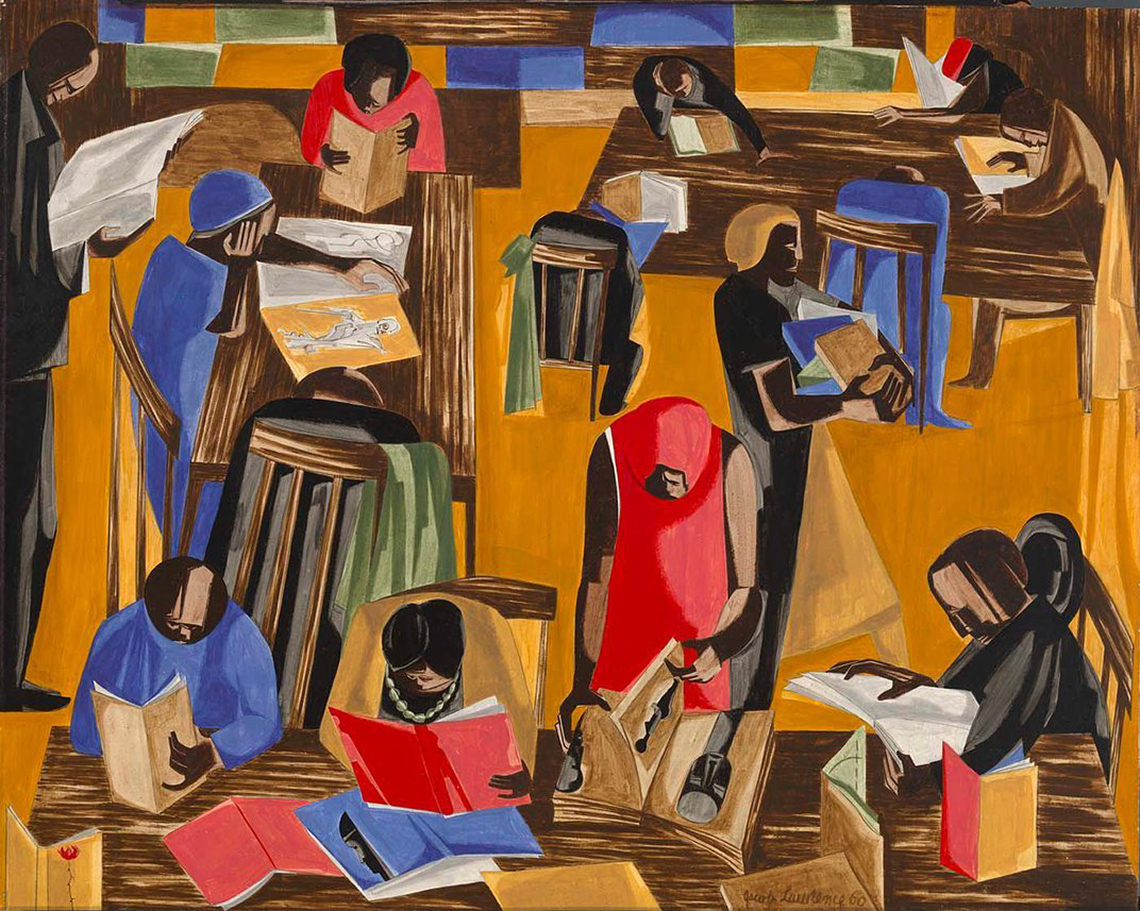
The Library by Jacob Lawrence, 1960
This painting shows a group of people in a library. The bold colours used are yellows, blues, and reds with browns and black included. There are about twelve people in this painting and most of them are sitting, reading. There are books, newspapers, magazines, being read and other books sitting on the tables around the people.
How has Jacob Lawrence used shape and/or colour to create this piece?
Press 'Hint' to access a clue.
What kinds of shapes do you notice? Do the colours repeat?
Pause and Reflect
Pause and reflect

Have you explored a library in your own community? What kind of books do you enjoy exploring?
Record your responses using a method of your choice.
Check your learning!
Select the correct answer, then press ‘Check Answer’ to see how you did.
Portfolio
Review your learning
Explore the following questions.
Record your responses using a method of your choice.
- What did you enjoy about the work of Jacob Lawrence?
- Jacob Lawrence told stories through his artwork. What is the difference between telling a story in a painting and telling a story with words?
- Why do you think people create work about their communities?
- Consider your own community. If you were creating art about your community, what might you include about the people and places in your community?
Reflection
How do you feel about what you have learned in this activity? Which of the next four sentences best matches how you are feeling about your learning? Press the button that is beside this sentence.
I feel…
Now, record your ideas about your feelings using a voice recorder, speech-to-text, or writing tool.